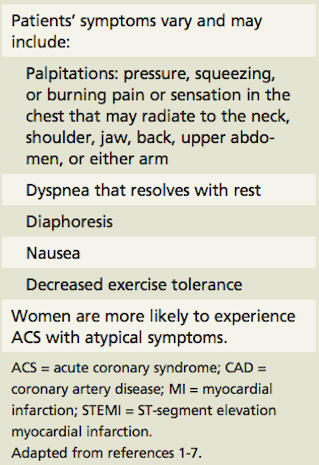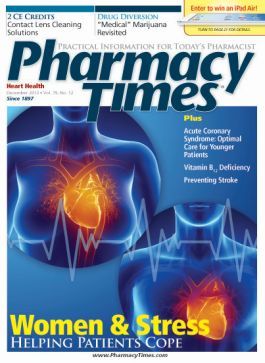Publication
Article
Pharmacy Times
Acute Coronary Syndrome: Optimal Care for Younger Patients
Author(s):
Research indicates that up to 10% of acute coronary syndrome patients are younger than 40 years old.
Research indicates that up to 10% of acute coronary syndrome patients are younger than 40 years old.
Coronary artery disease (CAD), a leading cause of life-compromising infirmity and premature death, is often a shocking development in adults we consider “young.” We generally associate CAD’s most alarming set of symptoms—acute coronary syndrome (ACS; Table 11-7)—with patients who are in middle age or are significantly older. Most of our current clinical approaches are based on knowledge of ACS’s pathology in patients older than 40 years, but research indicates that up to 10% of ACS patients are younger than 40 years.1-4 Researchers are now working to understand ACS in these patients. We need to look at what we know—and what we don’t know—to provide younger patients with the best possible care.
Who’s Young? It’s Relative
When discussing ACS, young doesn’t mean pediatric. Most researchers know that the vast majority of ACS occurs in people who are in their late 40s or older. For that reason, a young ACS patient is generally defined as younger than 45 years, but the definition may change in some studies. Additionally, having a first-degree relative who has CAD is a significant risk factor for younger patients.8-10
Risk Factors in the Young
A recent study looked at patients (n = 128) 46 years or younger admitted to an emergency department with an ACS diagnosis between 1999 and 2007. These patients represented 6.7% of all patients admitted with ACS, confirming that most ACS occurs in older individuals. Among the study population, 94% of patients were men, 83% were current smokers, 42% had comorbid dyslipidemia, 29% were hypertensive, and just under 5% were diabetic. Most patients (69%) had ST-segment elevation myocardial infarction (STEMI), 20% had non-STEMI, and 9% had unstable angina.4
Swiss researchers recently published a prospective cohort study of ACS in patients 35 years and younger. Among 28,778 patients with ACS identified between January 1997 and October 2008, 195 patients (0.7%) were younger than 35 years. Approximately 92% of the younger patients reported chest pain compared with 84% of older patients. Younger patients were less likely to have heart failure and significantly more likely to have STEMI than were older patients (73.1% vs 58.3%). As in the study discussed above, smoking (77%) and dyslipidemia (44%) were prevalent risk factors. More than half of patients reported a family history of CAD, and 58% were overweight.10
Old, Young? What’s the Difference?
Most studies show that people who develop ACS at young ages are generally male, a finding reflecting estrogen’s cardioprotective effects (ACS incidence increases in postmenopausal women). As in so many diseases, smoking is a serious risk factor in young ACS patients.4,7,10,11
STEMI appears to be more common in younger ACS patients, probably because these patients have less collateral circulation development. In contrast, older patients whose atherosclerosis and blockages accumulate slowly over many years have more time to develop collateral circulation. Younger patients are also more likely to report classic symptoms and to seek emergency care early.4 Recreational drug use causes ACS in a very small number of patients, and they are more likely to be among the youngest subset of ACS patients.2,4
Treatment


When a younger adult experiences ACS, aggressive medical intervention is imperative. Inpatient treatments must be aggressive and appropriate based on the patient’s specific diagnosis. Before discharge, clinicians will plan continuing outpatient care based on risk stratification. Some patients will need serious cardiac rehabilitation, while others will need only office- or community-based interdisciplinary health care education.9
At discharge, the number of drugs recommended by current clinical practice guidelines can overwhelm patients, so it’s important to explain each drug. It’s also important to tell patients that many of these drugs improve survival but not necessarily quality of life.9,10 Table 1 described the drugs usually prescribed in very general terms; pharmacists should review clinical practice guidelines (most of which are available for free) for specifics. In addition to these drugs, patients will need medication for other comorbidities (Online Table 2).
Pharmacists should not forget to emphasize lifestyle changes, with smoking cessation a primary focus because we can provide extensive guidance on appropriate interventions.
Table 2: Critical Medications for Acute Coronary Syndrome Patients Post-Discharge
Drug Therapy and Target Population
Reason
Prophylactic aspirin given indefinitely unless contraindicated or not tolerated
Reduce the incidence of recurrent MI; this reduces mortality rate by 23%
P2Y12 inhibitor (clopidogrel) for 12 months if drug-eluting stents are placed
Reduce cardiovascular death, myocardial infarction, and stroke
Beta-blockers indefinitely in all patients who have had a MI unless contraindicated
Suppress ventricular ectopy due to ischemia or excess catecholamines; if myocardial ischemia is present, beta-blockers have antiarrhythmic properties and reduce myocardial oxygen demand due to heart rate elevations and inotropy
Angiotensin-converting enzyme inhibitors for all patients with a history of MI, especially if the left ventricular ejection fraction is <40%; angiotensin-receptor blockers may be used as an alternative
Reduce mortality rates
Statins for all patients unless contraindicated; the low-density-lipoprotein cholesterol goal should be <100 mg/dL (or <70 mg/dL for very high risk patients)
Reduce atherosclerosis
Calcium channel blockers for patients with non-STEMI who cannot take beta-blockers and patients without heart failure or decreased left ventricular ejection fraction
Provide negative inotropic effects, cardiac pacemaker depression, slower conduction, and smooth muscle relaxation; reduce angina episodes and increase exercise duration
Oral nitrates for patients with ongoing angina or ongoing ischemia
Relieve symptoms, contribute to coronary blood flow redistribution by augmenting collateral flow and lowering ventricular diastolic pressure
Therapeutic warfarin therapy (international normalized ratio 2-3) for 3 months in patients with large anterior infarctions
Reduce risk of systemic emboli
MI = myocardial infarction.
Adapted from reference 8.
Closing Thoughts
Cardiologists manage ACS today far differently than they did just a few decades ago. Our diagnostic tools, invasive strategies, and drug options are better. Large-scale randomized controlled trials are under way around the world to find better ways to save patients’ lives. Despite our advances, complicated drug regimens can be challenging for patients. This is where pharmacists can have a great impact if they take the time to counsel well.
Virginia Bartok is a retired pharmacist who comes out of retirement to write. Her primary practice was in indigent care, and she currently provides case management for several patients.
References
- Choudhury L, Marsh JD. Myocardial infarction in young patients. Am J Med. 1999;107:254-261.
- Egred M, Viswanathan G, Davis GK. Myocardial infarction in young adults. Postgrad Med J. 2005;81:741-745.
- Barakat K, Wilkinson P, Deaner A, Fluck D, Ranjadayalan K, Timmis A. How should age affect management of acute myocardial infarction? A prospective cohort study. Lancet. 1999;353:955-959.
- Teixeira M, Sá I, Mendes JS, Martins L. Acute coronary syndrome in young adults. Rev Port Cardiol. 2010;29:947-955.
- Osula S, Bell GM, Hornung RS. Acute myocardial infarction in young adults: causes and management. Postgrad Med J. 2002;78:27-30.
- El Menyar AA. Drug-induced myocardial infarction secondary to coronary artery spasm in teenagers and young adults. J Postgrad Med. 2006;52:51-56.
- Doughty M, Mehta R, Bruckman D, et al. Acute myocardial infarction in the young. The University of Michigan experience. Am Heart J. 2002;143:56-62.
- Fihn SD, Gardin JM, Abrams J, et al. American College of Cardiology Foundation; American Heart Association Task Force on Practice Guidelines; American College of Physicians; American Association for Thoracic Surgery; Preventive Cardiovascular Nurses Association; Society for Cardiovascular Angiography and Interventions; Society of Thoracic Surgeons. 2012 ACCF/AHA/ACP/AATS/PCNA/SCAI/STS Guideline for the diagnosis and management of patients with stable ischemic heart disease: a report of the American College of Cardiology Foundation/American Heart Association Task Force on Practice Guidelines, and the American College of Physicians, American Association for Thoracic Surgery, Preventive Cardiovascular Nurses Association, Society for Cardiovascular Angiography and Interventions, and Society of Thoracic Surgeons. J Am Coll Cardiol. 2012;60:e44-e164.
- Anderson JL, Adams CD, Antman EM, et al. 2012 ACCF/AHA focused update incorporated into the ACCF/AHA 2007 guidelines for the management of patients with unstable angina/non-ST-elevation myocardial infarction: a report of the American College of Cardiology Foundation/American Heart Association Task Force on Practice Guidelines. J Am Coll Cardiol. 2013;61:e179-e347.
- Schoenenberger AW, Radovanovic D, Stauffer JC, et al. AMIS Plus Investigators. Acute coronary syndromes in young patients: presentation, treatment and outcome. Int J Cardiol. 2011;148:300-304.
- Barakat K, Wilkinson P, Deaner A, Fluck D, Ranjadayalan K, Timmis A. How should age affect management of acute myocardial infarction? A prospective cohort study. Lancet. 1999;353:955-959.







